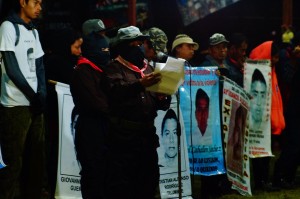
Comunicados EZLN
The Storm, the Sentinel, and the Night Watch Syndrome
Dear friends and enemies: so… err… umm… the thing is… well… remember that at the end of our March 19, 2015 text entitled “About the Homage and the Seminar,” we said that the organization of the seminar was a mess? Well, we have honored that claim: the email address to which we asked you to send your registration information is wrong, erroneous, in other words, that’s not the one. The correct email is: seminario.pensamientocritico15@gmail.com. Okay, okay, okay. It’s on me. Sincerely, yo merengues.
The Storm, the Sentinel, and the Night Watch Syndrome
April 2015.
To the compañeroas of the Sixth:
To all those interested:
Although it may not look like it, the following is an invitation… or is it a challenge?
If you are an adherent to the Sixth, if you are from the free, autonomous, alternative, independent media or whatever it’s called, if you are interested in critical thought, then accept this invitation to the seminar, “Critical Thought versus the Capitalist Hydra.” If in addition to accepting this invitation you would also like to attend the seminar, please follow this link: http://enlacezapatista.ezln.org.mx/registro-al-seminario-de-reflexion-y-analisis-el-pensamiento-critico-frente-a-la-hidra-capitalista/
If you are an invited speaker,[i] a similar letter will be sent to you via the same channels through which you have already been contacted. The difference will be that the invitation letter sent to the speakers will contain a “secret clause.”
Ok then, the invitation is really something like the wrapping paper.
Inside, further down below and to the left, you will find…
The Challenge
Oh, I know. The classic beginnings to a Zapatista reflection: disconcerting, anachronistic, silly, absurd. As if not really putting in any effort, as if just sort of putting it out there, a kind of “we’ll leave you to it,” or “see what you can do with it,” or something like “it’s on you.” It’s almost like they toss out a piece of a jigsaw puzzle and expect that people would understand that they are not just describing one part of reality, but have the entire image in mind. As if they saw the completed jigsaw puzzle, with its precise figures and colors in place, but with the border of each piece still visible, as if to point out that the whole exists because of all the parts, and of course, that each part acquires its meaning in relation to all the others.
Sobre Homenaje y Seminario. El SupGaleano
ZAPATISTA ARMY FOR NATIONAL LIBERATION.
March 2015.
To the compas of the Sixth in Mexico and in the World:
Compas:
I have been asked to let you know that…
Despite the significant increase in military activity in the vicinity of the Zapatista Caracoles (aggressive patrols, intimidating checkpoints, threatening flyovers)—particularly in the caracoles of La Realidad and Oventik (the first has just opened a school-clinic, and the second will host the tribute to Don Luis Villoro Toranzo)…
Despite the growing belligerence of the paramilitary groups sponsored by the Chiapas government…
Despite the tired “new” lies in the paid media /no, there is not and there has not been any proposal for dialogue; no, not since 2001, that is to say that no federal official has approached the EZLN in the last 14 years for any reason other than in an attempt to assasinate the Zapatista leadership; no, the federal and state governments are not looking to improve the living conditions of indigenous people in Chiapas, rather, they are trying to divide communities; no, the only governmental approaches that Jaime Martinez Veloz claim for himself were not to Zapatistas but to the paramilitaries backed (before he took over) by Luis H. Alvarez, Juan Sabines Guerrero, Felipe Calderon Hinojosa, and now Manuel Velasco Coello, Rosario Robles Berlanga and Enrique Peña Nieto, one of whose groups (the CIOAC-H) is responsible for the murder of the compañero teacher Galeano; no, and so forth and so on/…
Despite the fact that truth and justice are still missing in Ayotzinapa…


